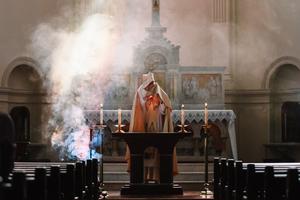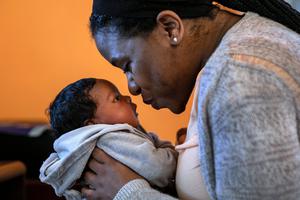Catholic College Boom: Smaller Institutions Thrive as National Enrollments Take a Hit
Record-breaking freshmen classes speak to the focus on Catholicity.

With many institutes of higher learning taking a hit following a year of lockdowns, restrictions and economic uncertainty, some Catholic colleges and universities find themselves thriving, challenging national trends with record-breaking enrollments for the 2021-2022 academic year.
The University of Dallas, Ave Maria University, Christendom College and Thomas Aquinas College are among the Catholic institutes of higher learning to report incoming classes as being substantially higher than any previous class. These trends in fall-semester enrollments among Catholic institutions are in contrast to reports at the national level from earlier this year. Colleges and universities nationwide saw a 3.5% decline this past spring, as compared to the year before, according to the National Student Clearinghouse Research Center, with undergraduate enrollments taking a significant hit. Numbers for the fall 2021 semester enrollments at the national level have yet to be reported.
A common thread among the Catholic institutes that are reporting unprecedented growth is a similar response to the COVID-19 pandemic and their commitment to maintaining in-person classes for their student body. “I think that our approach to the whole COVID complexity was a factor here,” Jonathan Sanford, president of University of Dallas, told the Register. Throughout the pandemic, classes were predominantly in-person — in contrast to many universities with online offerings — and prospective students continued to be welcomed to tour the campus. Around 500 first-time students enrolled at UD this year, beating the college’s previous record by nearly 100. “It’s definitely related in part to the fact that we’ve stayed open,” Sanford said.
University of Dallas also set itself apart by being one of a very small number of institutes to continue its semester-in-Rome program through the pandemic — along with Christendom College — despite strong restrictions on both sides of the Atlantic.
The decision to move forward with the Rome program “was a considered choice,” Sanford said, admitting, “We didn’t know exactly what that would look like. It took some institutional courage.”
Students attending the Rome program were subject to Italy’s quarantine and COVID-testing requirements, and various historic sites were closed due to the pandemic. Nonetheless, students had positive feedback about the experience. “I’m really just impressed with the way in which the dean there happily handled and responded in a really creative way,” Sanford said. “It was a different Rome semester than we’ve had in other years. We couldn’t go to Greece, for instance. But we found valuable visits for the students.”
Likewise, Christendom cites its COVID response as a significant factor in attracting incoming students. “The response to COVID for many families was the real draw,” namely, “that commitment to in-person education and the on-campus experience,” said Sam Phillips, director of admissions at Christendom College, in an interview with the Register. Christendom’s COVID response has involved having a nurse on staff and making accommodations for students who needed to quarantine, as well as for professors with underlying health conditions that put them at risk.
Alongside these safety precautions, the college has maintained in-person classes throughout the pandemic, leaving it up to individual professors to enforce mask-wearing in their classrooms. The college also does not require vaccinations.
In addition, Christendom has remained open for campus visits to prospective students — both during the academic year and for the high-school summer program — which encouraged visits from families who otherwise hadn’t considered the college and who ended up enrolling. “They fell in love with the student body. They saw the joy of the culture here and Catholicity,” Phillips said.
After having initially provided online support, Ave Maria University was also able to maintain an in-person class experience through the 2020-2021 academic year, thanks in part to its remote location in Florida. This fall, the university saw an increase in enrollment that was 35% higher than the previous five-year average. “Ave Maria University is kind of uniquely positioned. It’s a little bit of a barrier between us and the rest of the world,” said Kevin Murphy, vice president for marketing and communications for AMU. “The growing population here in town is maybe 10,000. We were kind of somewhat set off from a lot of the repercussions from COVID.”
“We were in person with our classes all of last year,” Murphy explained. “Not only did we offer it through the whole year, but we never went to online-only classes. There were a lot of circumstances that we had to kind of manage through, but I think we did a great job. And, by the grace of God, we didn’t have a large outbreak.”
While not record breaking, other Catholic institutions experienced a boost in enrollment. Franciscan University of Steubenville in Ohio, which has long included an online component to its curriculum, saw an increase as well, boasting its second-largest incoming class in history and marking its largest number of returning students, a representative of the university told the Register.
Another factor for new students entering college and university in 2021 is that they do so following a year of social and political uncertainty and unrest, an experience that has not escaped administrators at Catholic institutions. “This is something in the culture that is sparking this kind of kickback,” said Murphy. “When you’re presented with the fullness of truth, which I think only happens at an authentic Catholic university, they recognize it, and they gravitate toward it.”
Likewise, Thomas Aquinas College has also observed a draw from students toward a program steeped in Catholic culture and academic integrity. “It is appealing to the college’s students that our academic program not only predates current tensions, but transcends them,” said Chris Weinkopf, director of communications for Thomas Aquinas.
Between its long-established campus in California and its newer campus in Massachusetts, Thomas Aquinas College joins the list of institutions with record numbers, with 500 students enrolled. Like University of Dallas, Christendom and Ave Maria University, Thomas Aquinas College has maintained in-person classes, while keeping up with local health directives.
“The Church’s rich intellectual tradition offers a solid foundation, morally, intellectually and spiritually, which is always compelling, but especially during troubled times,” Weinkopf told the Register.
As for Christendom, Phillips said with regard to the cultural climate, “it’s so great to have a place that’s offering normalcy and an oasis of sanity in this world, both in terms of response to anxieties in the world, but also in terms of moral and philosophical presentations.”
The ultimate draw for students, University of Dallas’ Sanford said, is “a craving for, ultimately, friendship” — with peers, professors, and staff — and friendship “with truth and the God who is the source of all truth.”
As Michael West, affiliate assistant professor of English, said: “UD is a true oasis: It’s a place where study and prayer are distinct but are both treated with the utmost seriousness, where we ask hard questions of each other and where we draw on the insights of both Catholics and of non-Christians, ancients and moderns.”
Freshman Catherine Brecount, 18, from Cincinnati, concurs. “I chose UD because it provided the kind of liberal arts education that I was longing for. ... I felt confident that a UD education could shape me into a wiser, more authentic, and more virtuous woman. The culture at UD allows space to ponder life’s deepest questions.”
- Keywords:
- ann schneible
- catholic colleges
















